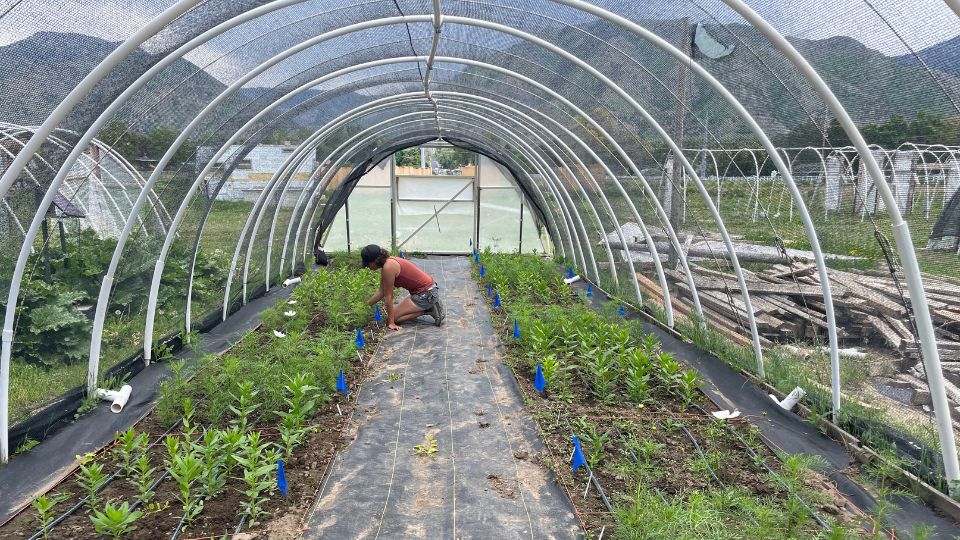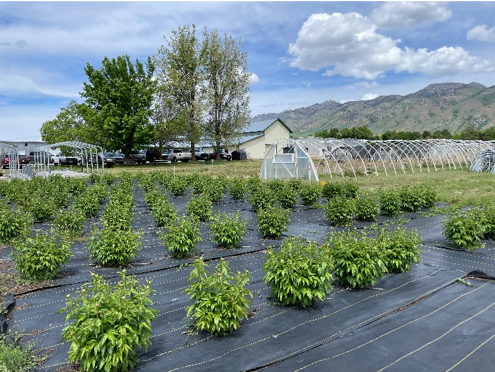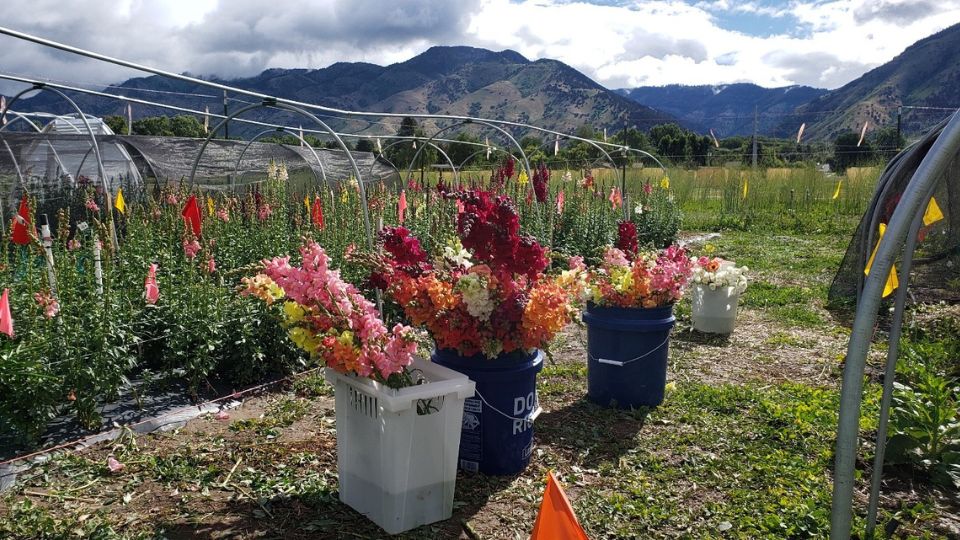An Overview of the Cut Flower Industry

Overview
For generations, flowers have been used to show affection and appreciation, given as gifts, and used for decoration or ornamentation (Oppenheim, 1996). Defined as flowers, blooms, or buds separated from their bearing plant that may be sold as single stems, bunches, or premade bouquets, cut flowers have an important role in the U.S. economy (Ford et al., 2012; PR Newswire, 2022; Rihn et al., 2014; Scoggins, 2019). It is estimated that Americans buy about 10 million cut flowers each day, with floriculture sales across all retail outlets reported at $6.43 billion (National Agricultural Statistics Service [NASS], 2022; Society of American Florists [SAF], 2022; Tegethoff, 2023). In 2021, Americans spent $171 per capita on floriculture products (SAF, 2022).
While studies indicated in the early 2010s that the floriculture retail industry was in a mature stage with decreasing demand for fresh cut flowers and floral products, especially among younger consumers (Rihn et al., 2011), just prior to the COVID-19 pandemic, the demand for cut flowers increased for decorative purposes and health benefits associated with cut flower usage. Benefits included reduced stress and improved sleep (Darras, 2021; PR Newswire, 2022; Yablonski, 2021). Cut flower sales also increased in Europe from 2006 to 2016 (Darras, 2021). Supply chain concerns and disruptions related to pandemic restrictions limited industry growth, but with restrictions now eased and limitations phased out, the U.S. cut flower market is expected to grow exponentially (PR Newswire, 2022).
In the U.S., there were approximately ten thousand floriculture producers in 2021 (NASS, 2022). The Society of American Florists further reports there are 12,154 retail florist shops and an estimated 500 wholesale cut flowers distributors (SAF, 2022). Florida has the highest cut flower sales in the nation, followed by California (NASS, 2022).
The cut flower industry in Utah is small, with approximately 40 acres dedicated to producing cut flowers in 2022, but it is dynamic and rapidly growing (Curtis & Stock, 2023). The number of flower farms increased dramatically from fewer than 20 farms in 2018 to 199 in 2023. These operations are often new, small businesses, commonly urban micro farms, and usually run by women aged 30 to 40 years, a traditionally underserved demographic in agriculture (Curtis & Stock, 2023). The average size of cut flower farms in Utah in 2022 was roughly half an acre but cut flowers do not require large amounts of land to produce a profit (Columbia & Stock, 2021).
Traditional and Specialty Cut Flowers

Cut flowers are commonly divided into two categories: traditional and specialty. Specialty cut flowers include all decorative plant materials except for roses, carnations, or chrysanthemums (Scoggins, 2019; Yue & Hall, 2010). These “big three” flowers are identified as traditional cut flowers and dominate the market as worldwide bestsellers. However, this definition is largely determined by market preferences, which previously included flowers such as lilies, tulips, and gladioli until they lost favor in the market due to their shorter vase lives (Darras, 2021; Yue & Hall, 2010).
Several factors distinguish traditional and specialty cut flowers. Traditional cut flowers are typically cultivated in large quantities year-round in greenhouses and are often imported, especially outside of the typical U.S. growing season (Darras, 2021). Specialty cut flowers, on the other hand, are usually cultivated in smaller quantities during a shorter growing season (Darras, 2021). They are mainly sold at local farmers markets as they don’t tolerate transportation as well as traditional cut flowers and can only be stored for limited amounts of time (Anderson, 2021; Darras, 2021; Nobes et al., 2021). Additionally, a range of hybrids exist for traditional flowers, while specialty cut flowers rarely include hybrid varieties (Darras, 2021).
Because traditional cut flowers are bestsellers, they offer assurances to growers and sellers in the dynamic floral market (Darras, 2021; Yue & Hall, 2010). However, imported cut flowers are associated with concerns related to increased energy demands, significant CO2 footprints, pesticide residues, and environmental legislation (Darras, 2021).
While research on the production and postharvest handling of specialty cut flowers is ongoing, most studies demonstrate that specialty cut flowers have the potential to provide sustainable solutions for growers and consumers concerned with environmental implications (Darras, 2021). Local specialty cut flower production in the U.S. increased over the past two decades and challenged traditional flower imports (Darras, 2021). From 2005 to 2011, specialty cut flower production grew from 81% to 91% of total domestic U.S. cut flower production (Ortiz et al., 2012).
Internationally Sourced Flowers
Though time in transit and adverse transportation handling and conditions reduce vase life, the U.S. cut flower market is attractive to foreign and international growers who can produce flowers often at lower costs than domestic growers due to lower wage rates, weaker foreign currencies, and fewer and less significant investments in climate control systems (Knoch, 2022; Rihn et al., 2014). The advent of air transportation and temperature control systems in trucks further encouraged the concentration of the cut flower industry to locations with climates more favorable for flower cultivation (Bergmann, 2019). As many as 80% of all cut flowers sold in the U.S. are imported, with the majority coming from Columbia, Ecuador, Holland, and African countries such as Kenya that have the climate for the year-round cut flower cultivation (Cain, 2022; Knoch, 2022; Li et al., 2016; Tegethoff, 2023).
As part of the War on Drugs in the 1990s, the U.S. passed the Andean Trade Preference Act (ATPA), allowing for tax-free flower imports from South America. U.S. legislators hoped to provide South American farmers with alternatives to growing coca that would ultimately be used to produce cocaine (Fitzgerald, 2018; Hand, 2019). It is unclear if the ATPA significantly reduced drug traffic, but it did allow for less expensive imported flowers to enter the U.S. market with prices domestic growers couldn’t compete with (Fitzgerald, 2018; Hand, 2019). Since ATPA expired in 2013, domestic cut flower growers have rebounded and begun to take up a more significant portion of the U.S. flower market (Fitzgerald, 2018).
After flowers are harvested overseas, they are sent to auctions and markets for wholesale buyers before being packaged and shipped to distribution points and warehouses along the supply chain and ultimately reaching retail businesses and consumers (Cain, 2022). On the journey, these delicate stems must be handled carefully and refrigerated at precisely controlled temperatures (Cain, 2022; Darras, 2021). As many specialty cut flower varieties don’t tolerate the transportation process well and thus do not last through extended storage times, they are ignored by large international distributors (Anderson, 2021). Imported flowers primarily include roses, carnations, and chrysanthemums as well as gerbera daisies and orchids; these flowers tolerate shipping well and constitute the bulk of flowers commonly used in florists’ arrangements (Ford et al., 2012).
Locally Sourced Flowers

Unable to compete with the lower prices and sheer volume of blooms produced by international operations, U.S. flower farms often turn to rarer varieties of specialty cut flowers unavailable from international distributors and provide high-quality stems (Anderson, 2021; Cain, 2022). The more fragile blooms that may not ship well or have short vase lives are a valuable niche for local growers (Cain, 2022; Ford et al., 2012). Traditional varieties of rose, chrysanthemum, and carnation are still grown domestically but not at the volumes they are imported. Sunflowers, zinnias, lisianthus, dahlias, lilies, daffodils, irises, and tulips are all commonly grown in the United States. The English tea rose (scented), heirloom carnation (scented), and mums as cuts are particularly in high demand.
Beyond just the type of flowers grown, local flower farms differ significantly in size compared to international operations. Cultivation on less than one acre is typical for many local growers, and most grow on less than five acres (Curtis & Stock, 2023; Ford et al., 2012). However, as noted, cut flower production does not require a large amount of land to produce a profit (Columbia & Stock, 2021). Unlike their international counterparts, these local growers primarily produce flowers in fields, rather than greenhouses, though they may use season extension methods to shelter flowers from weather, winds, and pests (Ford et al., 2012; Nobes et al., 2021).
Due to the highly entrepreneurial nature of small cut flower farms, many growers sell directly to consumers at farmers markets, through community-supported agriculture (CSA) programs, and agritourism or “U-pick” operations (Columbia & Stock, 2021; Curtis & Stock, 2023). Local growers, particularly those with more experience, may also work with wholesale cut flower distributors, florists, or event services, especially those interested in specialty flower varieties (Columbia & Stock, 2021; Curtis & Stock, 2023). Small-scale cut flower growers often need to be small business professionals as well as growers, with skills in marketing, accounting, and logistics (Anderson, 2021).
Local cut flower growers face several obstacles, including weather and climate concerns, pests, insects, and diseases that will reduce the marketability of their crop even if the plants survive (Ford et al., 2012; Nobes et al., 2021). Depending on the cultivar and variety grown by each operation, the specific challenges and best practices for addressing them may vary (Ford et al., 2012). Various insects and pests cause damage to different flowers, requiring growers to become familiar with their crops and which insects are harmful and beneficial; for example, aphids and thrips cause economic damage to flower farms, while lacewings act as beneficial pollinators (Ford et al., 2012). All flowers, however, are susceptible to weather damage. Though the dry climate in the Intermountain West prevents plant diseases such as powdery mildew that are common in more humid environments, local flowers have a very short growing season compared to imported flowers grown in a more optimal climate year-round (Fitzgerald, 2018; Nobes et al., 2021; Ortiz et al., 2012).

The short flower growing season means that crops require protection from frost, high winds, and large fluctuations in temperature from day to night, as well as seasonally; growers may opt to use season extension (e.g., high tunnels, low tunnels, or mulches) (Jean, 2023; Nobes et al., 2021). Heavy rains during bloom can damage petals and reduce marketability (Ford et al., 2012; Miller et al., 2021). High winds can break or bend stems, and encourage short stem growth, significantly reducing value as standards for cut flowers (Ford et al., 2012). Site selection can reduce wind damage and provide protection, but if that is not feasible, growers may opt to use windbreaks, such as fences or hedges (Ford et al., 2012), and tunnels.
The short growing and marketing season for local cut flowers has encouraged many growers to explore season extension methods. While greenhouses provide a climate-controlled environment with carefully managed heat and ventilation, they are expensive to build and maintain (Ford et al., 2012) and thus prohibitive to most small farms. Additionally, because many locally cut flowers are grown in fields, there are limited options for controlling temperature and growing conditions. Intermountain West cut flower studies confirm that high tunnels effectively protect crops from the elements and extend the growing season (Nobes et al., 2021; Lewis et al., 2021). High tunnels can allow for successful planting 4 to 6 weeks earlier than non-protected crops and another 4 to 6 weeks of additional production following the first frost in the fall when unprotected flowers would falter (Columbia & Stock, 2021; Ford et al., 2012).
Conclusions
Though international growers have dominated the cut flower market in recent decades, domestic flower production is increasing, with many unique types of specialty cut flowers now grown in the United States (Cain, 2022; Ford et al., 2012; Li et al., 2016). By providing specialty cut flowers that do not tolerate the transportation process from distant fields overseas, local growers are able to fill a niche in the market and earn significant income even with short growing seasons (Anderson, 2021; Cain, 2022). Local cut flower farms are often smaller and primarily sell their products through direct-to-consumer markets, such as local florists, farmers markets, and community-supported agriculture (CSA) programs. Growers often implement season extension methods, such as high tunnels, to address the challenges of growing flowers in the climate and short growing season in the Intermountain West.
References
-
Anderson, L. (2021). From plot to vase: farming flowers. The Horticulturist, 30(2),12–15.
-
Bergmann, B. (2019). A brief history of specialty cut flower production. North Carolina State Extension News. https://cutflowers.ces.ncsu.edu/welcome/brief-history-of-specialty-cut-flower-production/
-
Cain, S. (2022, February 2). Where have all the flowers gone? The New York Times. https://www.nytimes.com/2022/02/02/style/flower-supply-shortage.html
-
Columbia, S. L. & Stock, M. (2021). Cut flowers for community supported agriculture production [Fact sheet]. University of Kentucky Extension. https://www.uky.edu/ccd/marketready/CutFlowerCSA
-
Curtis, K. R., & Stock, M. (2023). Research report: Growing a new cut flower industry: Market needs and preferences. Journal of Food Distribution Research, 54(1), 1–7.
-
Darras, A. (2021). Overview of the dynamic role of specialty cut flowers in the international cut flower market. Horticulturae, 7(3), 51. https://doi.org/10.3390/horticulturae7030051
-
Fitzgerald, K. (2018, February 27). Edible garden – flowers. Edible Reno-Tahoe. https://ediblerenotahoe.com/editions/summer2018/summer2018-edible-garden-flowers/
-
Ford, T., Kime, L., Harper, J. K., & Bogash, S. (2012, December 17). Cut flower production. Penn State Extension. https://extension.psu.edu/cut-flower-production
-
Hand, G. (2019, September 29). Slow flowers: Cultivating beauty with nature’s help. Edible Idaho. https://edibleidaho.ediblecommunities.com/shop/slow-flowers-1
-
Jean, R. (2023, May 7). Slow isn’t just for food anymore – slow flower movement is blooming in Wyoming. Your Wyoming News Source. https://cowboystatedaily.com/2023/05/07/slow-isnt-just-for-food-any-more-slow-flower-movement-is-blooming-in-wyoming/
-
Kamenetsky, R., & Dole, J. (2012). Herbaceous peony (Paeonia): Genetics, physiology and cut flower production. Floriculture and Ornamental Biotechnology, 6(Special Issue 1), 62–77.
-
Knoch, J. (2022). BLOOM BOOM: We’re putting more thought into where our food comes from, but what about our blooms? Look inside the gorgeous, growing, female-led slow flowers revolution. Chatelaine, 95(5), 32–38.
-
Lewis, M., Stock, M., Black, B., Drost, D., & Dai, X. (2023, February 23). Field production methods for season extension of peony ‘Coral Charm’. HortScience, 58(4). DOI: https://doi.org/10.21273/HORTSCI16942-22
-
Lewis, M., Stock, M., Ward, R., Black, B., Drost, D. (2021). Peony cut flower production budget, one field, northern Utah, 2020 [Fact sheet]. Utah State University Extension. https://digitalcommons.usu.edu/extension_curall/2166/
-
Li, Z., McCracken, V., & Connolly, J. (2016, July 31–August 2). An evaluation of factors influencing consumer purchase decisions of cut flowers, a study of Washington consumers [Paper presentation]. Agricultural and Applied Economics Association Conference, Boston, MA, United States. https://ageconsearch.umn.edu/record/235227/?ln=en
-
Miller, A., Ford, T., & Kime, L. (2021, January 5). Sunflower u-pick. Penn State Extension. https://extension.psu.edu/sunflower-u-pick
-
National Agricultural Statistics Service (NASS). (2022). 2021 floriculture crops [Highlights, No. 2022]. U.S. Department of Agriculture. https://www.nass.usda.gov/Publications/Highlights/2022/Floriculture_Highlights_07.pdf
-
Nobes, S. R., Panter, K. L., & Jabbour, R. (2021). Greenhouse and high tunnel production of Specialty Cut Flowers. HortTechnology, 31(6), 753–762. https://doi.org/10.21273/horttech04894-21
-
Oppenheim, P. P. (1996). Understanding the factors influencing consumer choice of cut flowers: A means-end approach. Acta Horticulturae, (429), 415–422. https://doi.org/10.17660/actahortic.1996.429.52
-
Ortiz, M. A., Hyrczyk, K., & Lopez, R. G. (2012). Comparison of high tunnel and field production of specialty cut flowers in the midwest. HortScience, 47(9), 1265–1269. https://doi.org/10.21273/hortsci.47.9.1265
-
PR Newswire. (2022, April 28). United States cut flowers market forecast report 2021–2028: Marketing strategies adopted by the market players & increase in demand for cut flowers for decorative purposes. Cision. https://www.prnewswire.com/news-releases/united-states-cut-flowers-market-forecast-report-2021-2028-marketing-strategies-adopted-by-the-market-players--increase-in-demand-for-cut-flowers-for-decorative-purposes-301535232.html
-
Rihn, A. L., Yue, C., Hall, C., & Behe, B. K. (2014). Consumer preferences for longevity information and guarantees on cut flower arrangements. HortScience, 49(6), 769–778. https://doi.org/10.21273/hortsci.49.6.769
-
Rihn, A. L., Yue, C., Behe, B., & Hall, C. (2011). Generations X and y attitudes toward fresh flowers as gifts: Implications for the floral industry. HortScience, 46(5), 736–743. https://doi.org/10.21273/hortsci.46.5.736
-
Scoggins, H. (2019, March 6). Marketing specialty cut flowers. Community, Local & Regional Food Systems. https://foodsystems.extension.org/marketing-specialty-cut-flowers/
-
Society of American Florists (SAF). (2022, December 14). Floral industry facts. safnow.org. https://safnow.org/trends-statistics/floral-industry-facts/
-
Tegethoff, E. (2023, April 13). Growers tout the benefits of local cut flowers. Utah Public Radio. https://www.upr.org/utah-news/2023-04-13/growers-tout-the-benefits-of-local-cut-flowers
-
Yablonski, B. (2021, November 5). 19 proven benefits of flowers (leading research studies). Petal Republic. https://www.petalrepublic.com/benefits-of-flowers/#:~:text=Fortunately%2C%20flowers%20can%20help%20increase,fatigue%20and%20increase%20energy%20levels.
-
Yue, C., & Hall, C. (2010). Traditional or specialty cut flowers? Estimating U.S. consumers’ choice of cut flowers at noncalendar occasions. HortScience, 45(3), 382–386. https://doi.org/10.21273/hortsci.45.3.382
Published December 2023
Utah State University Extension
Peer-Reviewed Fact Sheet
Authors
Makaylie Langford, USU Extension Intern, Department of Applied Economics;
Kynda Curtis, Professor & USU Extension Specialist, Department of Applied Economics;
Melanie Stock, Assistant Professor & USU Extension Specialist, Department of Plants, Soils, and Climate
Related Research






